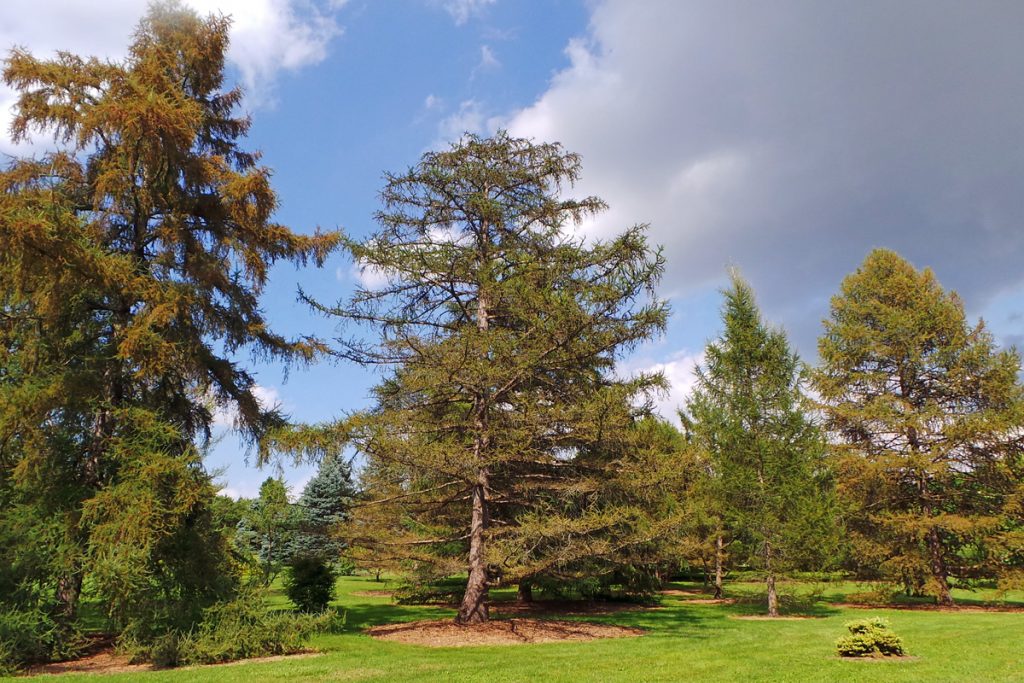
The larches (Larix spp.) are unusual conifers, in that they are deciduous and drop all their leaves each autumn, unlike their evergreen cousins. They are among the earliest trees to come into leaf in spring, with leaves on both short shoots (spurs) and long shoots. Clusters of leaves arise from each spur.
The needle-like leaves are usually vivid green, sometimes blue-green in summer and turn butter yellow to old gold in autumn. Upright, summer-ripening cones are borne on the shorter shoots and remain on the tree for some time. In older trees, the branches tend to droop in a graceful manner. Larches are adaptable to most soils, though wet soils are best avoided for most species. All need full sun, and are readily transplanted when dormant. Species hybridize readily, in the wild and in cultivation. They propagate readily from seed.
Larix occurs in boreal circumpolar lowlands in Alaska, Canada and Russia, and at moderate to high altitudes in the mountains of North America, northern Europe, and over much of Asia from Siberia as far south as northern Myanmar. There are about 11 species (there is some debate about the Asian ones). The most commonly available larch for landscaping is the European larch and its hybrids.
The European larch, Larix decidua (= europaea), is hardy to zone 2. In its native range in the Alps and Caucasian mountains, it forms extensive forests at high altitudes. It has also naturalized in other parts of northern Europe on moist soils in temperate regions. This tree was important in European folklore, being traditionally considered to prevent enchantment and ward off evil spirits – infant children sometimes wore collars of larch bark as protection against the evil eye. Various preparations of larch were also used for medicinal purposes. A brown dye was also obtained from the needles in autumn.

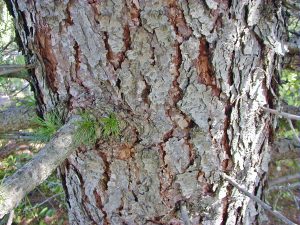
This large, graceful conifer will grow from 70 to 100 feet tall and can attain a diameter up to 2 feet. It grows with a straight trunk and an open crown, becoming pyramid shaped with age. The conical crown becomes broader as the tree matures, with some wide-spreading horizontal as well as erect branches. The bark is greenish grey-brown and smooth at first but becomes fissured vertically on older trees. The trunk becomes pink-brown with deep, broad, scaly ridges.
The soft needles are borne in clusters arsing from short spurs on the long branches or on long shoots. Leaves emerge a tender light green in very early spring and deepen to a medium green by summer. They turn a rich yellow color before shedding late in the fall. The dropped needles form a soft mulch under the tree.


European larch bears both male and female cones on the same tree (monoecious) at the tips of short lateral shoots on young branches. The short-lived, small, globular to oblong male cones are only seen in the spring. They are a yellow to tan color with a loose collar of papery scales and quickly release the pollen for cross-pollination by the wind.

The egg-shaped, upright, persistent female cones are longer than the needles, with 40-50 scales. These cones start out a somewhat showy red to pinkish-purple color and mature to softly woody brown cones the first year. Each scale in this cone has a membranous bract and a pair of winged seeds at the base,. Cones open in the fall and shed seeds are dispersed throughout the winter and following spring in the wind. Many trees retain dead cones for ten years or more. Unlike the other large-coned larch species, European larch cones have scales that are straight or slightly incurved at the tips, rather than open or reflexed.
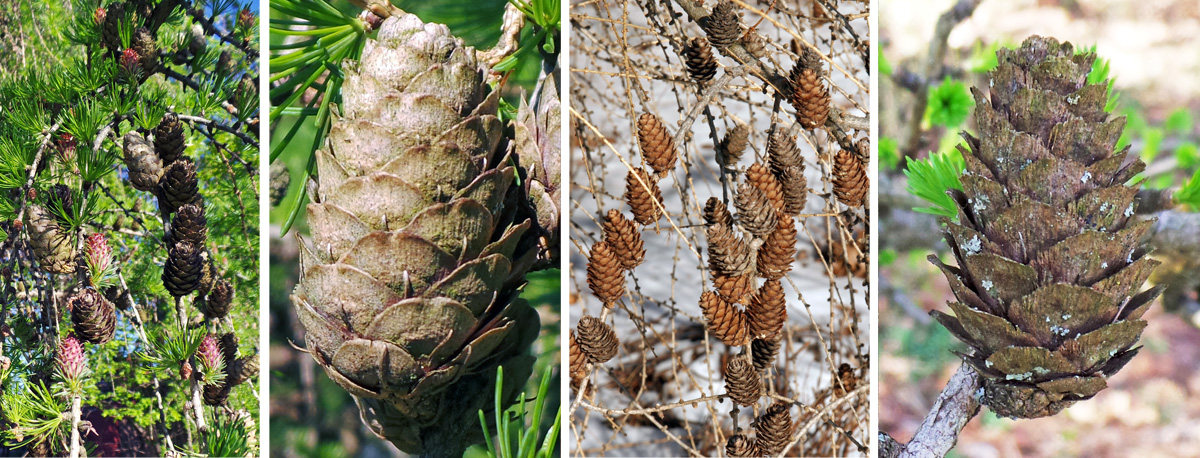
On the North American continent European larch is most commonly planted in southeastern Canada and the northeastern United States, where it makes a great ornamental tree. Young trees establish very quickly and grow vigorously, putting on 12 to 18 inches of growth annually. European larch does best with sufficient moisture, well-drained and sunny conditions; it does not grow well in very dry or wet soils.
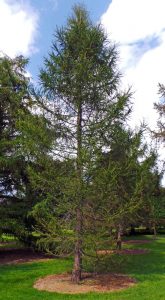
There are a few cultivars of European larch, including ‘Corley,’ which makes a dwarf spreading tree, ‘Horstmann’s Recurva’ a semi-dwarf tree with contorted branches, ‘Pendula,’ a small version of the original that weeps down to the ground, and ‘Puli’, a newer weeping form that maintains a more narrow shape than ‘Pendula’. In addition to these and other cultivars are hybrids such as Larix x marschlinsii (Dunkeld larch), a natural hybrid between L. decidua and L. kaempferi that was first raised on the estate of the Duke of Athol at Dunkeld, in Scotland, in 1904. Intermediate between its parents, it differs only in the yellow, slightly waxy-bloomed shoots and conical cones. ‘Varied Directions’ has pendulous branches. Larix x pendula, a hybrid between L. decidua and L. laricina is very similar to L. decidua. This cross has also given rise to at least a couple of garden forms that are quite distinctive plants. ‘Contorta’ has twisted young branches and ‘Repens’ is a spreading ground cover that is very attractive when its foliage turns gold in autumn.
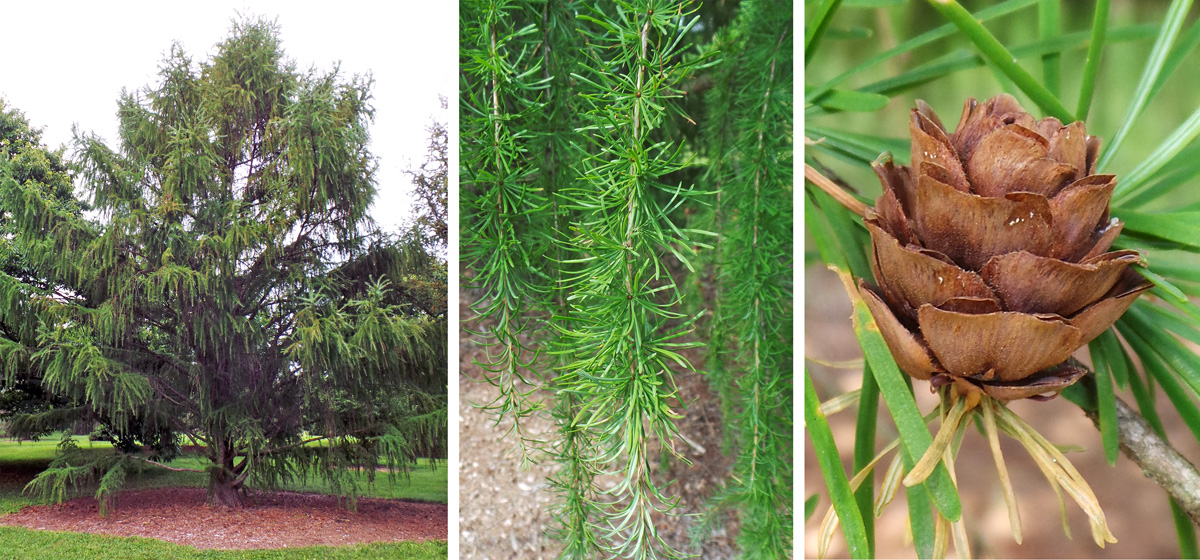
Other species of larch that are less commonly available for horticultural use include:
- Larix gmelinii (Dahurian larch) is found in Siberia east of the River Yenisei, where it hybridizes with L. sibirica to cover vast tracts of land. It has a rather open crown, slender at the top, but is more often seen as low and dense. The leaves are slender, bright shiny grass green, with two whitish bands on the undersurface. The young cones are a deep rosy purple in summer, ripening to a shiny pale brown. ‘Romberg Park’ has a rounded form. Zones 2-9.
- Larix kaempferi (Japanese larch) is common in its native Japan, where plantations cover huge areas in the western hills. It is less common in cultivation than European larch, although it withstands atmospheric pollution better. It has very long low branches sweeping out and up; the upper branches also sweep upwards. Mature trees can be 100 feet tall with scaly rusty-brown bark. The leaves are broader and grayer-green than European larch. The cones are brown, flattened and bun-shaped with the edges of the scales turned out and down. ‘Pendula’ and ‘Stiff Weeping’ both have pendulous branches, while ‘Diane’ has an upright form with contorted branches. Zones 4-9.

- Larix laricina (American larch, eastern larch, tamarack larch) is found across most of northern North America growing in sphagnum bogs and swampy places. It rarely gets more than 60 feet tall. The crown is open, often with twisted and hooped branches. Young trees have upright slender branches. The bark is pink to reddish brown, finely flaking and not fissured. The leaves are dark green above with 2 broad gray bands above and underneath. The small, blunt and cylindrical cones are shorter than the needles and are numerous over the outer crown. The cultivar ‘Deborah Waxman’ maintains a small, pyramid shape. ‘Steuben’ has blue-green foliage. Zones 2-8.
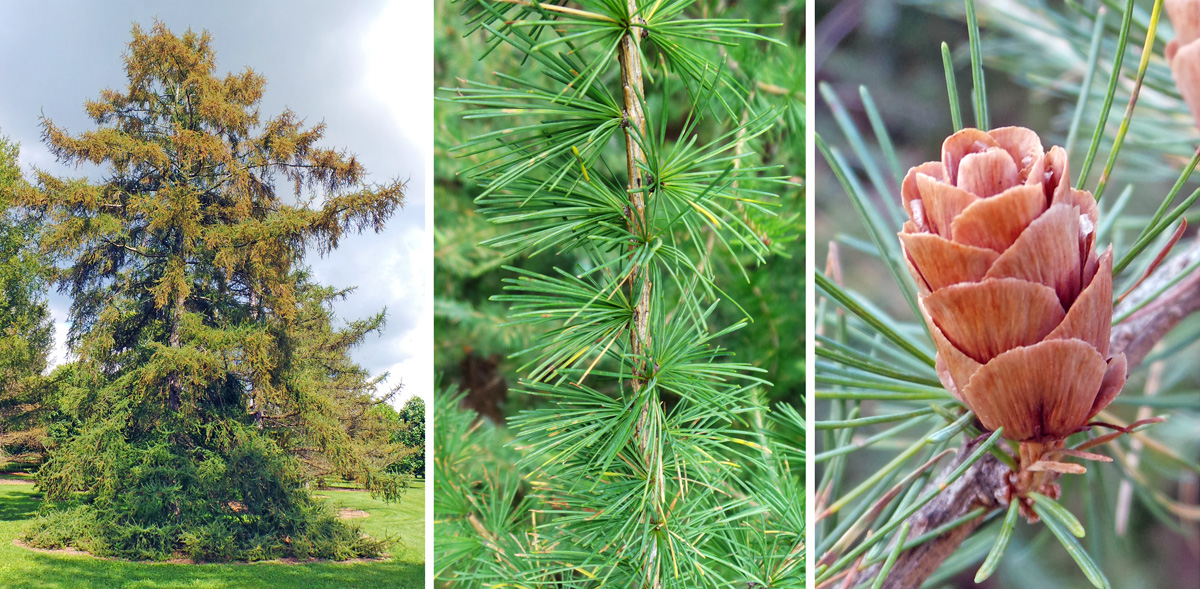
- Larix lyallii occurs in subalpine areas of western North America, where it is often covered in heavy snow. This small- to medium-sized tree up to 40 feet tall is easily recognized by its densely felted young shoots and 4-angeld grayish green leaves. The twigs are densely woolly and the bark is thin, furrowed and scaly. Zones 2-8.
- Larix occidentalis (western larch) occurs naturally in Oregon, Washington, Idaho and Montana and British Columbia, Canada. It is the tallest of all the larches, growing up to 180 feet tall. Some trees develop a swollen base. The bark is purplish gray, deeply and widely fissured, while the crown is rather open and narrowly conical. The leaves are about 1½ inches long and bright green on both surfaces. The cones are a rich purple in summer with orange and yellow bracts and ripen to purple-brown. Zones 3-9.
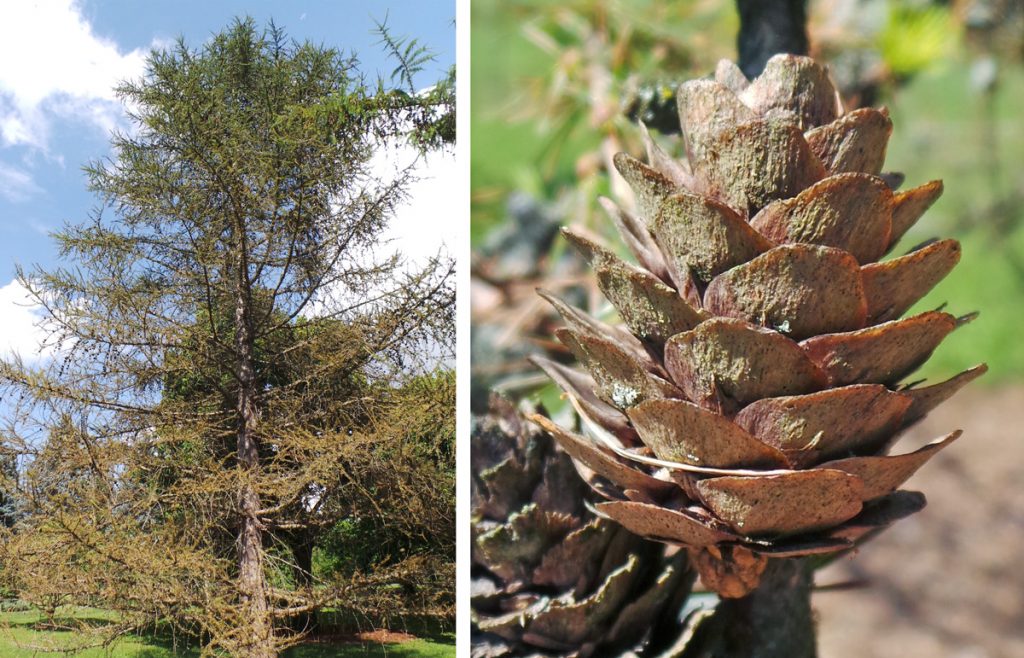
- Larix potannii (Chinese larch) is widely distributed in the mountainous areas of southern Gansu and Sichuan Provinces in China. This handsome medium-sized tree to 70 feet has long blue-gray leaves and drooping branches with orange-brown to purplish shoots. The leaves are 4-angled and have a distinctive fragrance when crush. The cones are oblong-ovoid. This species does not grow well outside its native country. Zones 5-9.
- Larix sibirica (=russica) (Siberian larch) is an extremely hardy tree from western Siberia and northeastern Russia that can grow to 100 feet tall. It has attractive red-brown bark that becomes deeply furrowed and gnarled with age. The branches sweep down, rising at the tips, ensuring that heavy snow does not build up on them. The very narrow leaves are slightly over 1 inch long, beginning soft bright green in spring and turning to gold in autumn when the tree is also covered with small scaly cones. Zones 1-8.
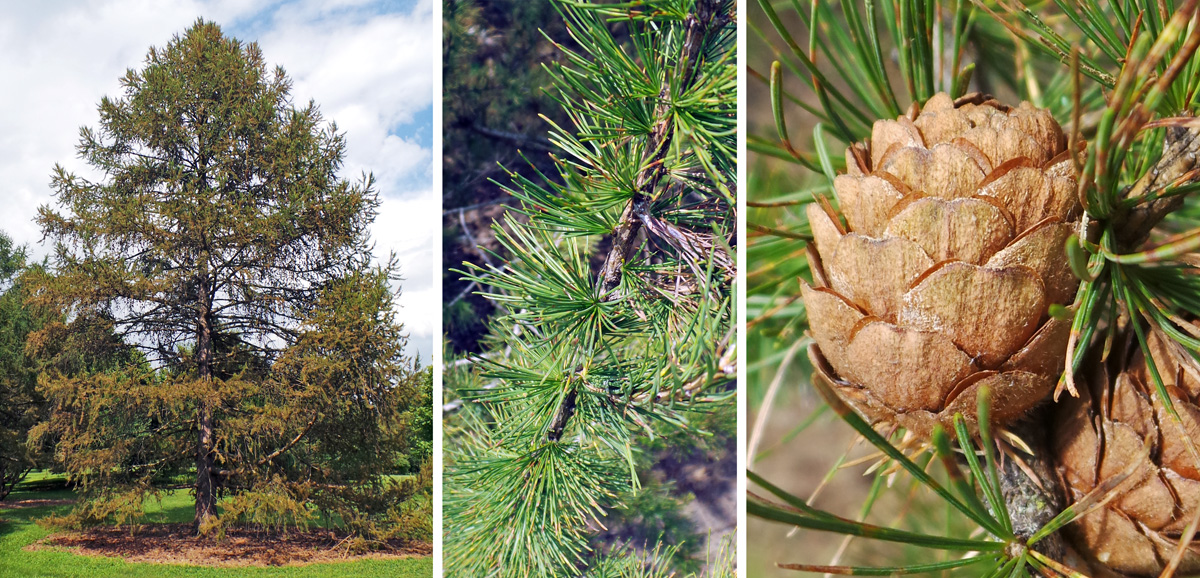
– Susan Mahr, University of Wisconsin – Madison





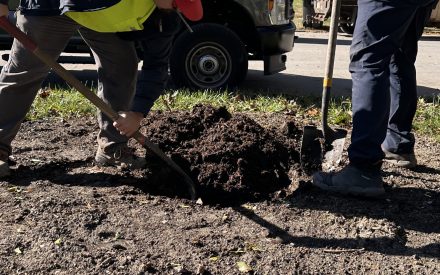 Promoting Urban Forestry: Planting Bareroot Trees in Home Landscapes
Promoting Urban Forestry: Planting Bareroot Trees in Home Landscapes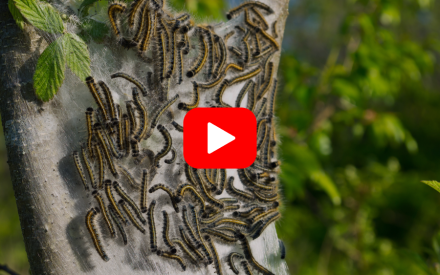 ▶︎ Watch: Torching Tent Caterpillars
▶︎ Watch: Torching Tent Caterpillars ▶︎ Watch: Planning for Fall Planting – Choosing the right trees and shrubs for success
▶︎ Watch: Planning for Fall Planting – Choosing the right trees and shrubs for success Silver Leaf
Silver Leaf


